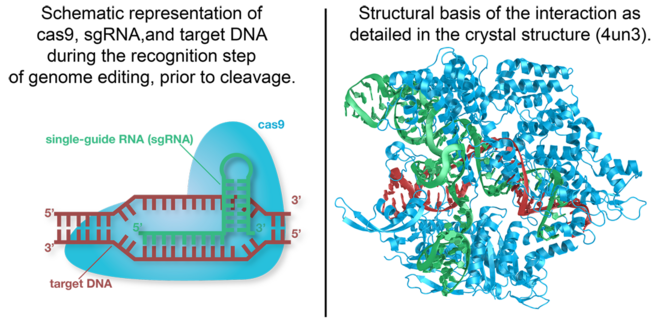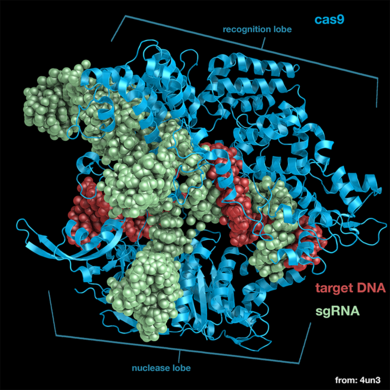Cas9
From Proteopedia
m |
|||
| Line 15: | Line 15: | ||
<center><html5media height=“315” width=“560” frameborder="0" allowfullscreen>https://www.youtube.com/embed/TdBAHexVYzc</html5media></center> | <center><html5media height=“315” width=“560” frameborder="0" allowfullscreen>https://www.youtube.com/embed/TdBAHexVYzc</html5media></center> | ||
| - | <center>Geneticist [http://rna.berkeley.edu/ Jennifer Doudna], from UC Berkeley, is one of the co-inventors of the groundbreaking </center> | + | <center>Geneticist and 2020 Nobel laureate [http://rna.berkeley.edu/ Jennifer Doudna], from UC Berkeley, is one of the co-inventors of the groundbreaking </center> |
<center>new technology for editing genes, called CRISPR-Cas9. The tool allows scientists , </center> | <center>new technology for editing genes, called CRISPR-Cas9. The tool allows scientists , </center> | ||
<center>to make precise edits to DNA strands, which could lead to treatments for genetic diseases … </center> | <center>to make precise edits to DNA strands, which could lead to treatments for genetic diseases … </center> | ||
| Line 21: | Line 21: | ||
<center>Doudna reviews how CRISPR-Cas9 works — and asks the scientific community </center> | <center>Doudna reviews how CRISPR-Cas9 works — and asks the scientific community </center> | ||
<center>to pause and discuss the ethics of this new tool.</center> | <center>to pause and discuss the ethics of this new tool.</center> | ||
| + | |||
| + | <center><br>Microbiologist and 2020 Nobel laureate Emanuelle Charpentier, from Max Planck Institute for Infection Biology in Berlin, is one of the co-inventors of the groundbreaking </center> | ||
| + | <center>new technology for editing genes, called CRISPR-Cas9. The tool allows scientists , </center> | ||
| + | <center>to make precise edits to DNA strands, which could lead to treatments for genetic diseases … </center> | ||
| + | <center>but could also be used to create so-called "designer babies." </center> | ||
| + | <center>Charpentier reviews how CRISPR-Cas9 works in [https://youtu.be/2pp17E4E-O8 this 2016 talk].</center> | ||
| + | |||
| + | |||
Articles in Proteopedia concerning Cas9 include: | Articles in Proteopedia concerning Cas9 include: | ||
Revision as of 14:57, 7 October 2020
Cas9 is the RNA-guided DNA endonuclease used by the CRISPR (clustered regularly interspaced short palindromic repeats)-associated systems to generate double-strand DNA breaks in the invading DNA during an adaptive bacterial immune response.
The CRISPR-associated endonuclease Cas9 has been exploited for use in genome editing systems. In such systems, an engineered single-guide RNA (sgRNA) is used to target double-stranded breaks in genomic DNA. Depending on what repair pathway is triggered, often dictated by the inclusion of additional engineered components, the targeted site either is disrupted or incorporates additional genetic sequences.
This video, by Paul Andersen, explains how the CRISPR/Cas immune system
was identified in bacteria and how the CRISPR/Cas9 system was developed to edit genomes.
a powerful new technology with many applications in biomedical research,
including the potential to treat human genetic disease.
Microbiologist and 2020 Nobel laureate Emanuelle Charpentier, from Max Planck Institute for Infection Biology in Berlin, is one of the co-inventors of the groundbreaking
Articles in Proteopedia concerning Cas9 include:
Contents |
3D structures of Cas9
Streptococcus pyogenes Cas9
- 4un3, 4un4, and 4un5 - S. pyogenes Cas9 bound to sgRNA and target DNA
- 4oo8 - S. pyogenes Cas9 bound to sgRNA and target DNA
- 4cmp
- 4cmq - Mn2+-bound S. pyogenes Cas9
Actinomyces naeslundii Cas9
See Also
References
Proteopedia Page Contributors and Editors (what is this?)
Wayne Decatur, Michal Harel, Karsten Theis, Joel L. Sussman, Ann Taylor, Thomas Gastineau


